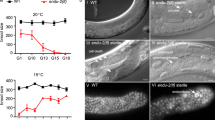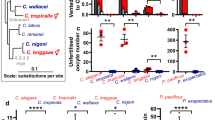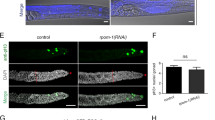Abstract
Unlike the soma, which ages during the lifespan of multicellular organisms, the germ line traces an essentially immortal lineage. Genomic instability in somatic cells increases with age, and this decline in somatic maintenance might be regulated to facilitate resource reallocation towards reproduction at the expense of cellular senescence. Here we show that Caenorhabditis elegans mutants with increased longevity exhibit a soma-to-germline transformation of gene expression programs normally limited to the germ line. Decreased insulin-like signalling causes the somatic misexpression of the germline-limited pie-1 and pgl family of genes in intestinal and ectodermal tissues. The forkhead boxO1A (FOXO) transcription factor DAF-16, the major transcriptional effector of insulin-like signalling, regulates pie-1 expression by directly binding to the pie-1 promoter. The somatic tissues of insulin-like mutants are more germline-like and protected from genotoxic stress. Gene inactivation of components of the cytosolic chaperonin complex that induce increased longevity also causes somatic misexpression of PGL-1. These results indicate that the acquisition of germline characteristics by the somatic cells of C. elegans mutants with increased longevity contributes to their increased health and survival.
This is a preview of subscription content, access via your institution
Access options
Subscribe to this journal
Receive 51 print issues and online access
$199.00 per year
only $3.90 per issue
Buy this article
- Purchase on Springer Link
- Instant access to full article PDF
Prices may be subject to local taxes which are calculated during checkout





Similar content being viewed by others
References
Curran, S. P. & Ruvkun, G. Lifespan regulation by evolutionarily conserved genes essential for viability. PLoS Genet. 3, e56 (2007)
Garsin, D. A. et al. Long-lived C. elegans daf-2 mutants are resistant to bacterial pathogens. Science 300, 1921 (2003)
Wang, D. & Ruvkun, G. Regulation of Caenorhabditis elegans RNA interference by the daf-2 insulin stress and longevity signaling pathway. Cold Spring Harb. Symp. Quant. Biol. 69, 429–431 (2004)
Wilkins, C. et al. RNA interference is an antiviral defence mechanism in Caenorhabditis elegans . Nature 436, 1044–1047 (2005)
Wang, D. et al. Somatic misexpression of germline P granules and enhanced RNA interference in retinoblastoma pathway mutants. Nature 436, 593–597 (2005)
Batista, P. J. et al. PRG-1 and 21U-RNAs interact to form the piRNA complex required for fertility in C. elegans . Mol. Cell 31, 67–78 (2008)
O'Neil, N. & Rose, A. DNA repair. WormBook Jan 13, 1–12 (2006)
Das, P. P. et al. Piwi and piRNAs act upstream of an endogenous siRNA pathway to suppress Tc3 transposon mobility in the Caenorhabditis elegans germline. Mol. Cell 31, 79–90 (2008)
Gartner, A., Boag, P. R. & Blackwell, T. K. Germline survival and apoptosis. WormBook Sept 14, 1–20 (2008)
Robert, V. J., Sijen, T., van Wolfswinkel, J. & Plasterk, R. H. Chromatin and RNAi factors protect the C. elegans germline against repetitive sequences. Genes Dev. 19, 782–787 (2005)
Kawasaki, I. et al. PGL-1, a predicted RNA-binding component of germ granules, is essential for fertility in C. elegans . Cell 94, 635–645 (1998)
Mello, C. C., Draper, B., Krause, M., Weintraub, H. & Priess, J. The pie-1 and mex-1 genes and maternal control of blastomere identity in early C. elegans embryos. Cell 70, 163–176 (1992)
Narbonne, P. & Roy, R. Inhibition of germline proliferation during C. elegans dauer development requires PTEN, LKB1 and AMPK signalling. Development 133, 611–619 (2006)
Ogg, S. et al. The Fork head transcription factor DAF-16 transduces insulin-like metabolic and longevity signals in C. elegans . Nature 389, 994–999 (1997)
Lin, K., Dorman, J. B., Rodan, A. & Kenyon, C. daf-16: An HNF-3/forkhead family member that can function to double the life-span of Caenorhabditis elegans . Science 278, 1319–1322 (1997)
Kenyon, C., Chang, J., Gensch, E., Rudner, A. & Tabtiang, R. A. C. elegans mutant that lives twice as long as wild type. Nature 366, 461–464 (1993)
Larsen, P. L. & Clarke, C. F. Extension of life-span in Caenorhabditis elegans by a diet lacking coenzyme Q. Science 295, 120–123 (2002)
Houthoofd, K., Gems, D., Johnson, T. E. & Vanfleteren, J. R. Dietary restriction in the nematode Caenorhabditis elegans . Interdiscip. Top. Gerontol. 35, 98–114 (2007)
Kaeberlein, T. L. et al. Lifespan extension in Caenorhabditis elegans by complete removal of food. Aging Cell 5, 487–494 (2006)
Furuyama, T., Nakazawa, T., Nakano, I. & Mori, N. Identification of the differential distribution patterns of mRNAs and consensus binding sequences for mouse DAF-16 homologues. Biochem. J. 349, 629–634 (2000)
Murphy, C. T. et al. Genes that act downstream of DAF-16 to influence the lifespan of Caenorhabditis elegans . Nature 424, 277–283 (2003)
Oh, S. W. et al. Identification of direct DAF-16 targets controlling longevity, metabolism and diapause by chromatin immunoprecipitation. Nature Genet. 38, 251–257 (2006)
Li, J. et al. Caenorhabditis elegans HCF-1 functions in longevity maintenance as a DAF-16 regulator. PLoS Biol. 6, e233 (2008)
Dalley, B. K. & Golomb, M. Gene expression in the Caenorhabditis elegans dauer larva: developmental regulation of Hsp90 and other genes. Dev. Biol. 151, 80–90 (1992)
Batchelder, C. et al. Transcriptional repression by the Caenorhabditis elegans germ-line protein PIE-1. Genes Dev. 13, 202–212 (1999)
Unhavaithaya, Y. et al. MEP-1 and a homolog of the NURD complex component Mi-2 act together to maintain germline-soma distinctions in C. elegans . Cell 111, 991–1002 (2002)
Beanan, M. J. & Strome, S. Characterization of a germ-line proliferation mutation in C. elegans . Development 116, 755–766 (1992)
Arantes-Oliveira, N., Apfeld, J., Dillin, A. & Kenyon, C. Regulation of life-span by germ-line stem cells in Caenorhabditis elegans . Science 295, 502–505 (2002)
Vijg, J. & Campisi, J. Puzzles, promises and a cure for ageing. Nature 454, 1065–1071 (2008)
Kenyon, C. The plasticity of aging: insights from long-lived mutants. Cell 120, 449–460 (2005)
van Haaften, G. et al. Identification of conserved pathways of DNA-damage response and radiation protection by genome-wide RNAi. Curr. Biol. 16, 1344–1350 (2006)
Pothof, J. et al. Identification of genes that protect the C. elegans genome against mutations by genome-wide RNAi. Genes Dev. 17, 443–448 (2003)
Hsin, H. & Kenyon, C. Signals from the reproductive system regulate the lifespan of C. elegans . Nature 399, 362–366 (1999)
Cui, M., Kim, E. B. & Han, M. Diverse chromatin remodeling genes antagonize the Rb-involved SynMuv pathways in C. elegans . PLoS Genet. 2, e74 (2006)
Kahn, N. W., Rea, S. L., Moyle, S., Kell, A. & Johnson, T. E. Proteasomal dysfunction activates the transcription factor SKN-1 and produces a selective oxidative-stress response in Caenorhabditis elegans . Biochem. J. 409, 205–213 (2008)
An, J. H. & Blackwell, T. SKN-1 links C. elegans mesendodermal specification to a conserved oxidative stress response. Genes Dev. 17, 1882–1893 (2003)
Tullet, J. M. et al. Direct inhibition of the longevity-promoting factor SKN-1 by insulin-like signaling in C. elegans . Cell 132, 1025–1038 (2008)
Olsen, A., Vantipalli, M. C. & Lithgow, G. J. Checkpoint proteins control survival of the postmitotic cells in Caenorhabditis elegans . Science 312, 1381–1385 (2006)
Kim, S. H., Holway, A. H., Wolff, S., Dillin, A. & Michael, W. M. SMK-1/PPH-4.1-mediated silencing of the CHK-1 response to DNA damage in early C. elegans embryos. J. Cell Biol. 179, 41–52 (2007)
Wolff, S. et al. SMK-1, an essential regulator of DAF-16-mediated longevity. Cell 124, 1039–1053 (2006)
D’Angelo, M. A., Raices, M., Panowski, S. H. & Hetzer, M. W. Age-dependent deterioration of nuclear pore complexes causes a loss of nuclear integrity in postmitotic cells. Cell 136, 284–295 (2009)
Pinkston-Gosse, J. & Kenyon, C. DAF-16/FOXO targets genes that regulate tumor growth in Caenorhabditis elegans . Nature Genet. 39, 1403–1409 (2007)
Libina, N., Berman, J. R. & Kenyon, C. Tissue-specific activities of C. elegans DAF-16 in the regulation of lifespan. Cell 115, 489–502 (2003)
Wolkow, C. A., Kimura, K. D., Lee, M. S. & Ruvkun, G. Regulation of C. elegans life-span by insulinlike signaling in the nervous system. Science 290, 147–150 (2000)
Murphy, C. T., Lee, S. J. & Kenyon, C. Tissue entrainment by feedback regulation of insulin gene expression in the endoderm of Caenorhabditis elegans . Proc. Natl Acad. Sci. USA 104, 19046–19050 (2007)
Lee, M. H. & Schedl, T. Identification of in vivo mRNA targets of GLD-1, a maxi-KH motif containing protein required for C. elegans germ cell development. Genes Dev. 15, 2408–2420 (2001)
Kim, J. K. et al. Functional genomic analysis of RNA interference in C. elegans . Science 308, 1164–1167 (2005)
Brenner, S. The genetics of Caenorhabditis elegans . Genetics 77, 71–94 (1974)
Fire, A. et al. Potent and specific genetic interference by double-stranded RNA in Caenorhabditis elegans . Nature 391, 806–811 (1998)
Acknowledgements
Some strains were provided by the Caenorhabditis Genetics Center, which is funded by the National Institutes of Health National Center for Research Resources. We thank A. Conery, H. Gabel, J. Melo, E. O’Rourke, D. Simon, A. Soukas and M. Wang for reagents, discussion and reading of the manuscript; G. Seydoux and members of the Ruvkun, Ausubel and Kaplan laboratories for discussion; S. Strome for the pie-1p::gfp::pgl-1 strain and C. Mello for monoclonal antisera against PGL-1, S. S. Lee, S. Ercan and the Kingston laboratory for technical advice on ChIP. This work was supported by grants from the National Institutes of Health and the National Institute on Aging F32-AG026207 to S.P.C. and R01-AG016636 to G.R. and the European Molecular Biology Organization and the Human Frontier Science Program to C.G.R.
Author Contributions S.P.C. and G.R. conceived and designed the experiments. S.P.C., X.W. and C.G.R. performed the experiments. S.P.C. and G.R. wrote the manuscript.
Author information
Authors and Affiliations
Corresponding author
Supplementary information
Supplementary Information
This file contains Supplementary Figures S1-S11 with Legends, Supplementary Tables S1-S3 and Supplementary References. (PDF 7960 kb)
Rights and permissions
About this article
Cite this article
Curran, S., Wu, X., Riedel, C. et al. A soma-to-germline transformation in long-lived Caenorhabditis elegans mutants. Nature 459, 1079–1084 (2009). https://doi.org/10.1038/nature08106
Received:
Accepted:
Published:
Issue Date:
DOI: https://doi.org/10.1038/nature08106
This article is cited by
-
ATP-dependent chromatin remodelers in ageing and age-related disorders
Biogerontology (2021)
-
University of Southern California and buck institute nathan shock center: multidimensional models of aging
GeroScience (2021)
-
Prostaglandin signals from adult germline stem cells delay somatic ageing of Caenorhabditis elegans
Nature Metabolism (2019)
-
DAF-16/FOXO and HLH-30/TFEB function as combinatorial transcription factors to promote stress resistance and longevity
Nature Communications (2018)
-
The contribution of dietary restriction to extended longevity in the malaria vector Anopheles coluzzii
Parasites & Vectors (2017)
Comments
By submitting a comment you agree to abide by our Terms and Community Guidelines. If you find something abusive or that does not comply with our terms or guidelines please flag it as inappropriate.



